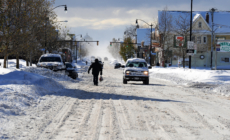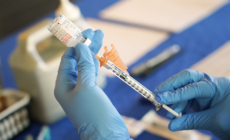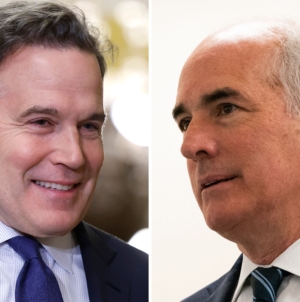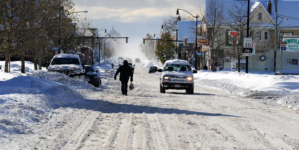-
Pennsylvania Senate Race Update: MAGA Celebrates as Bob Casey Concedes - 25 mins ago
-
Trump Tries on His Crown - 26 mins ago
-
Winter Weather Warnings in 15 States As 4 Feet of Snow To Hit - about 1 hour ago
-
West Bank Settlement Supporters Have Big Hopes for Trump’s Presidency - about 1 hour ago
-
US Delivers Military Planes to Vietnam in Rare Sale Since Cold War - 2 hours ago
-
Trump Picks Pam Bondi for Attorney General After Matt Gaetz Withdraws - 2 hours ago
-
How To Watch ‘Squid Game’ Before The New Season Premieres - 2 hours ago
-
How a Duct-Taped Banana Sold for $6.2 Million - 3 hours ago
-
Map Shows US States With Highest Levels Of Long COVID - 3 hours ago
-
Patriots Owner Robert Kraft Once Again Denied Induction into Hall of Fame - 3 hours ago
California’s summer COVID surge is over. But expect another spike

California’s protracted summer COVID surge has finally ended, a welcome window that provides a key opportunity to prepare for yet another expected resurgence of transmission this autumn and winter, doctors say.
Key to thwarting that threat is the availability of updated vaccines, which have been formulated to boost protection against recently dominant circulating coronavirus strains — the same approach used to develop the annual flu shot.
That’s why doctors are urging everyone age 6 months and older to get an updated COVID vaccine, ideally before Halloween. And unlike last year, the new shots have arrived on time and are plentiful.
“The single most effective thing that [people] can do to protect themselves as we get into fall and winter is to get vaccinated,” Dr. Mandy Cohen, director of the U.S. Centers for Disease Control and Prevention, said at a recent briefing. “We have an updated COVID vaccine, an updated flu vaccine, an RSV vaccine — all of those can help protect ourselves, our families, our communities.”
This summer’s COVID surge was particularly enduring. Viral levels in California wastewater were calculated as “high” or “very high” for 15 straight weeks, from the start of June through the first half of September, according to the CDC. That’s about as long as the 2022 midyear wave and twice as long as last year’s.
COVID levels in wastewater in California finally fell back into the “moderate” level for the week ending Sept. 21, the most recent for which data are available.
In Los Angeles County, coronavirus levels in wastewater have fallen for five straight weeks. For the 10-day period ending Sept. 14, the most recent available, coronavirus levels were at 45% of last winter’s peak. For the 10-day period ending Sept. 7, that measurement was 56%.
While the summer surge has left many who were recently infected with some degree of protection — at least for a few weeks or months — doctors say getting vaccinated remains important. Natural immunity from a past infection will fade, and the shots can help combat future spread and temper the worst COVID symptoms for those who become ill.
“These are vaccines that can allow us to risk less of the severe illnesses and do more of the things we enjoy. We want to be having those fun Thanksgiving holidays, those Christmas holidays, together as a family,” Cohen said at a briefing held by the National Foundation for Infectious Diseases.
One big challenge, though, is that despite widespread acceptance of COVID-19 vaccines when they first became available, interest in the annual updated shots has waned. An overwhelming majority of Americans got their primary COVID vaccination in 2021, but only a fraction chose to get an updated shot within the last year.
More than 95% of adults hospitalized last year due to COVID-19 hadn’t received an updated vaccine, according to Dr. Demetre Daskalakis, director of the CDC’s National Center for Immunization and Respiratory Diseases.
COVID-19 has become less deadly since the start of the pandemic, thanks to vaccinations, the development of new medications, and the buildup of immunity from prior infections. Still, the disease poses a greater public health risk than the flu.
Since Oct. 1, 2023, at least 56,000 COVID-19 deaths have been reported nationally, the CDC said. There were at least 17,000 flu deaths over the same time period, according to the agency’s latest estimate.
“COVID is still causing more hospitalizations and death than flu,” Cohen said. “So if you’re someone who has regularly gotten their flu shot, you want to add COVID to that.”
There’s also the continued risk of developing long COVID — an array of sometimes debilitating symptoms that can last months, if not years. According to a report published in the journal Nature Medicine in August, long COVID has affected 400 million people globally, and is estimated to have an annual economic impact of about $1 trillion, essentially about 1% of the worldwide economy.
“Long COVID can have devastating impacts on individual lives and, due to its complexity and prevalence, it also has major ramifications for health systems and economies,” the report said. “Addressing the challenge of long COVID requires an ambitious and coordinated — but so far absent — global research and policy response strategy.”
This autumn and winter are expected to be similar to last year in terms of the circulation of COVID, flu and respiratory syncytial virus, or RSV, Cohen said.
“If last season is any prediction of this season, that means 800,000 hospitalizations of flu, COVID and RSV,” Cohen said. “We know that these vaccines can cut the risk of hospitalization in half.”
Flu vaccines alone are estimated to have helped prevent at least 7.5 million cases of flu infections last year, she said.
The RSV vaccine is recommended for all those age 75 and older, as well as those ages 60 to 74 who are at increased risk of developing severe symptoms. Unlike the COVID and flu vaccines, the RSV vaccine isn’t annually administered, so those who got one last year don’t need to get another.
Up to 160,000 older adults are hospitalized for RSV annually, and the disease is responsible for 6,000 to 10,000 deaths each year, Daskalakis said.
“If you’re over 75 — slam dunk, you should also get a RSV shot,” he said.
An RSV vaccine is also available for expectant mothers at weeks 32 to 36 of pregnancy to pass protection to their fetuses. An antibody for the virus — which the CDC says is the leading cause of infant hospitalization in the U.S. — is available for babies and some young children, too.
Doctors say that the elderly and immunocompromised are most at risk for severe illness and death, and that getting an updated vaccine may be the critical difference in avoiding getting hospitalized this winter.
People can choose to get each of the COVID, flu and RSV vaccines at the same doctor’s visit.
“No time like the present to get those vaccines,” Daskalakis said. “They work, but they don’t work if they’re on the shelf. … [If you’re] someone who is, like, ‘Should I be getting my vaccine now?’ The time is now.”
COVID and flu vaccinations are also important for pregnant women, who are at higher risk of complications from both diseases, especially in their third trimester.
“If you vaccinate a pregnant person, their infants will benefit from that protection as well. This is particularly important because we don’t have a vaccine for babies in the first six months of life,” said Dr. Flor M. Muñoz, an associate professor of pediatrics and infectious diseases at the Baylor College of Medicine and Texas Children’s Hospital in Houston.
Babies in their first six months of life have one of the highest COVID-associated hospitalization rates — comparable to seniors age 65 to 74, according to a report published by the CDC Thursday. Among about 1,000 infants hospitalized with COVID for the 19-month period that ended in April, 22% were admitted to an intensive care unit, and nine died while hospitalized, the report said.
Among infants whose mothers’ COVID vaccination status was available, all of the babies who died in the hospital were born to moms with no record of vaccination during their pregnancy, the report said.
Flu is also a risk. During the 2023–24 season, 200 children nationally died from flu — a record number in a non-pandemic season, the CDC said. Among those children, roughly 80% were unvaccinated despite having been eligible for the flu shot.
Taking steps like washing your hands and wearing a mask in indoor public settings can reduce the risk of infection from illnesses like COVID, RSV or flu, doctors say.
U.S. households are now eligible to again receive four free at-home COVID tests sent through the mail. They’re being made available by the U.S. Department and Health and Human Services, and you can register at covidtests.gov. Tests started shipping on Monday.
There’s a lot of misinformation out there that masking isn’t helpful, which is nonsense, Dr. Reed Tuckson, a former health commissioner for the District of Columbia and the chair of the Black Coalition Against COVID, said at a news conference.
“Masks work in terms of not being able to spread a disease from one human being to another,” Tuckson said. “So whether you choose to wear it or not, please wear it or not based on the evidence that they are effective. But the end of the day is, how often do you have to do that? Use common sense, guided by a sense of [ethics] and morality.”
Another big no-no is showing up to work or events when you’re sick. Some people might still think they’ll be seen as a hero for working despite being “sick as a dog,” thinking it’ll show “how tough I am,” Tuckson said.
But there’s a less positive way to look at it, Tuckson said: “‘Let me tell you how rude I am and how willing I am to infect other people, just to show you what a great ego I am.’ Which side of that equation do you want to be on?”
A big challenge has been health misinformation. To the dismay of mainstream public health experts, Florida’s controversial health department — in opposition to federal guidance — advised against getting mRNA COVID vaccines. Federal health authorities have consistently maintained the immunizations are safe, effective and reduce the risk of severe illness and death.
Tuckson, a former president of the Charles R. Drew University of Medicine and Science in Willowbrook, blasted Florida’s messaging as containing misinformation.
“We have to double fight all this stuff that comes out of Florida… It means a drain on resources, a drain on time,” Tuckson said. “And I just am, quite frankly, infuriated that we would have to have yet another element that makes the fight for human life so much more difficult.”
There have been public health successes during the pandemic. Early in the COVID vaccination drive, a national survey found that the vaccination rates for Black and Latino residents lagged behind those of white residents. At the end of April 2021, 59% of white residents had received at least one dose of a vaccine, compared to 47% of Latinos and 46% of Black residents.
By the end of November 2021, however, vaccination rates for those three groups converged — with 78% of Black, 81% of Latino and 79% of white adults having received at least one vaccine dose, according to a report published by the CDC.
This was a notable success, Tuckson said.
“After a concerted, vigorous and leveraged action by Black America and others of goodwill, such as our colleagues here from the CDC, for the first time in history, we actually closed a disparities gap,” Tuckson said.
That progress shows just how it’s possible to “demonstrate extraordinary progress despite the obstacles and challenges,” Tuckson said. “We will have to really work hard to overcome this pervasive, targeted and malicious misinformation that is causing so much disease, illness and again, death in our community.”
Source link




















